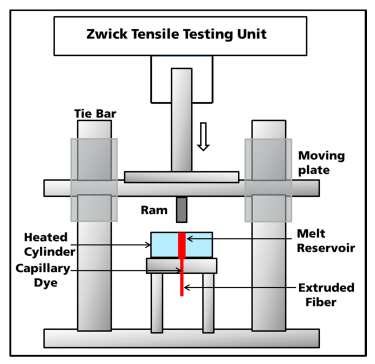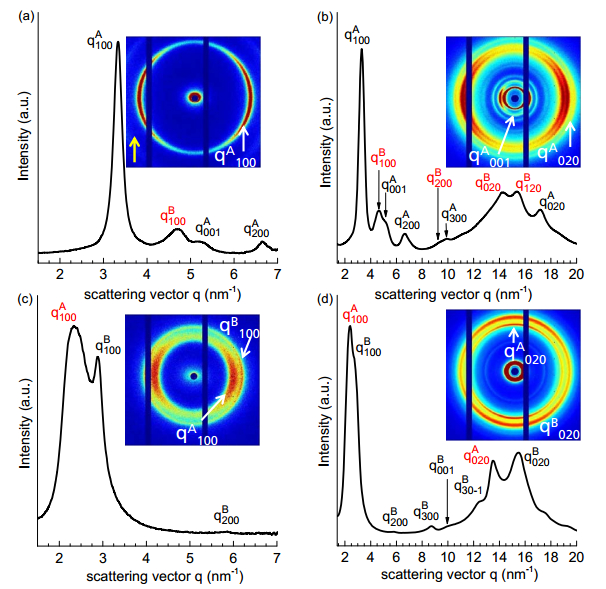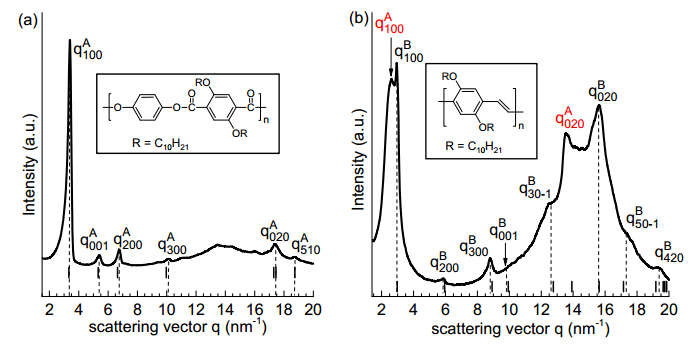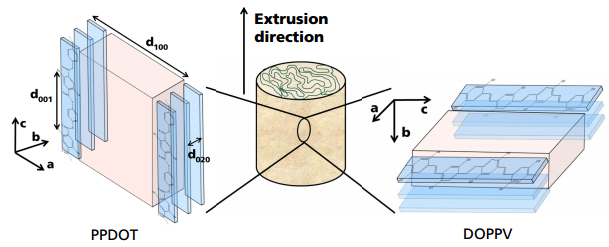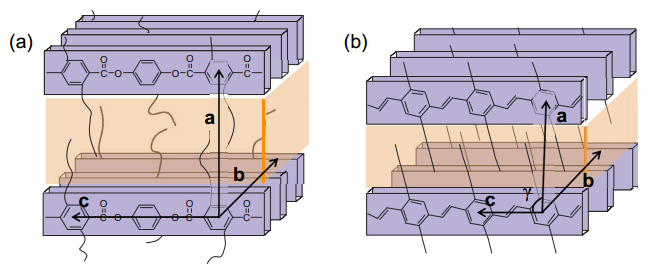The influence of shear fields on the packing behavior and morphology orientation are studied for two comb-like polymers viz. poly(1,4-phenylene-2,5-didecyloxy terephthalate) (PPDOT) and poly(2,5-didecyloxy-1,4-phenylenevinylene) (DOPPV) with different rigid backbones having C = 10 alkyl carbons per side chain. Crystallographic analysis based on X-ray diffractometry measurements shows that both PPDOT and DOPPV exhibit a long-range ordered layered structure with alternating main chains and alkyl nanodomains and can be characterized by an orthorhombic and monoclinic unit cell respectively. No measurable influence of processing on the unit cell of the individual polymers is observed comparing diffraction data on isotropic (powder) samples and extruded fibers. The main difference between the PPDOT and DOPPV is in the molecular orientation of the backbones in shear aligned fibers as observed from the 2D diffraction patterns. While, for PPDOT the polymer backbones align along the direction of extrusion (fiber axis), for DOPPV the backbones align perpendicular to the extrusion direction. A possible relation between differences in backbone orientation under influence of shear fields for DOPPV and PPDOT and differences in the packing state of the side chains, which are in a crystalline state for DOPPV but in a disordered state for PPDOT, is considered.
1.
Introduction
Mangroves are a precise coastal ecosystem contributing as a wealthy store of resident biodiversity. The diversity of the benthic infauna is largely underestimated and must undergo regular revision in order to detect and monitor changes of benthic communities within the area.
The benthic communities constitute a dominant component that supports habitat productivity to a greater extent. Due to this, the species composition may negatively affect the resident community and consequently impact trophic relationships within these communities as a result of any activity exerted, causing a change for sediment features [1,2]. Zainal et al. and Ali et al. pointed out that the macrobenthic faunal diversity around the Huwar islands [3,4] and Bahrain are very important in ecosystem balancing. Other regions, such as Europe [5,6], North America [7,8] and South Africa, have produced monographs for faunal identification [9]. However, most of the benthic faunal communities have not yet been thoroughly explored in India.
Kerala is gifted with a long coastal line and extensive estuaries. Estuarine water contains a rich supply of nutrients. No comprehensive study has been done so far on benthic infaunal biodiversity and abundance in this Chettuva mangrove area.
2.
Material and methods
2.1. Collection of water and sediment samples
The present study was designed to characterize the benthic infauna community of eight different sites in Chettuva mangrove, Kerala, as seen in Figure 1. Biological samples from each station, three replicate samples, were collected using benthic grab sampler. The procedure adopted for sampling was following the method of Mackie [10]. After collecting the samples, they were emptied into a plastic tray. The larger organisms were handpicked (extracted) immediately from the sediments and then sieved through 0.5 mm mesh screen. The organisms retained by the sieve were placed in a labelled container and fixed in 5%–7% formalin. Subsequently, the organisms were stained with Rose Bengal solution (0.1 g in 100 ml of distilled water) for greater visibility during sorting. All the species were sorted, enumerated and identified to the advanced possible level with the consultation of available literature. The works of Fauvel and Day and http://www.marinespecies.org/polychaeta/ were referred for identification [11].
2.2. Statistical analyses
Statistical software was used to analyze the data obtained from different sites [12]. This was done using various statistical methods, such as univariate, multivariate and graphical/distributional methods. Biodiversity indices were calculated for the infaunal community, which included diversity index (H') using the method of Shannon-Wiener's [13] formula, species richness (d) using the Margalef [14] formula and species evenness (J') using the Pielou [15] formula. Similarities (or dissimilarities) between sites were obtained showing the interrelationships of all through an MDS plot (non-metric Multi-Dimensional Scaling) [16,17]. Cluster analysis was also done to calculate the similarities. All the various statistical methodologies and calculations were obtained through the software PRIMER V7 (Plymouth Routines in Multivariate Ecological Research) developed by Plymouth Marine Laboratory.
3.
Results
3.1. Species Composition in Chettuva Mangrove
A total of 339 organisms were identified from eight samples, spanning 40 taxa from four phyla (Tables 1 & 2), representing an average of 42 specimens per sample. The species composition by phylum within the Chettuva Mangrove area was predominated by annelids with 72.27% (Figure 2). Arthropods formed the second most important group, represented by 15.93%. Mollusca constituted 9.73%, and the fourth important group was the Echinodermata, which comprised of 2.06%. Annelids composed the majority of the infaunal species composition (Table 1).
Among all the eight stations, Site 7 is the most abundant and diverse, with 55 individuals across 19 taxa. Capitellidae was the most numerous family, indicating a clear dominance. Samples with common abundant taxa are presented in Figure 3. Within the polychaetes, Capitellidae, Opheliidae, Spionidae and Terebellidae were found to be the most recurring species in the samples collected within this mangrove ecosystem. With respect to arthropods, Anoplodactylus sp. and Apseudidae were the most abundant species.
3.2. Dominance
Figure 5 represents the k-dominance curves for each station at each area. These plots illustrate the cumulative abundance of infauna plotted against the species rank. The curves are formulated from both a richness measure (species rank) and an evenness measure (% cumulative dominance).
The results of the dendrogram show that species from these eight sites were grouped to two major categories (Figure 7). Among these sites, site 4, site 6, and site 7 form a separate group while all other sites are branched to from a major group.
Table 3 shows the total abundance per site, number of species and their diversity indices; Margalef species richness, Pielou species evenness and the Shannon-Weiner diversity index. Graphs of the biodiversity indices by site can be seen in Figure 6.
The three indices provide an indication of the diversity of each of the samples based on the number of species, number of individuals and the distribution of individuals between species. A more settled community will generally have a greater number of species with individuals spread more evenly between them, while a stressed or recovering community will tend to be numerically dominated by a small number of species and have fewer species overall.
Margalef species richness index (d) is heavily influenced by the overall number of species measured, though it makes a slight allowance for the number of individuals. Higher values indicate a greater number of species per individual. Margalef species richness index (d), values are ranged between 2.89 and 4.74 showing reasonably moderate to high richness. Pielou's species evenness index (J') reflects the level of spread of the individuals between the species and lies between 0 (uneven) and 1 (even). The Shannon-Weiner diversity index (H') lies between 1.94 to 2.75, indicating an average diversity. The total number of species and individuals present was influenced by salinity regimes, sediment types, organic content food availability [18]. etc. Overall, the range of species present in all samples combined suggests a moderately high level of diversity [19,20,21,22].
Multivariate analyses were conducted to investigate resemblances in the infaunal assemblages between sites across the study area (Clarke and Gorley). A Bray-Curtis (BC) similarity matrix was used to calculate the percentage similarity between all infaunal sites based on all the species present and their abundances. The samples from each site were summed so that the focus of the analysis was on similarities and differences between locations. To ensure better representation for presence/absence of taxa rather than the analysis being dominated by the most numerous species, a fourth-root transformation was applied.
To assist with visualizing relationships between sites, the BC values have been displayed as a dendrogram (group average), in which sites where the communities are more comparable (i.e., have a higher percentage similarity value) split from one another further down the diagram.
The BC values are also used to create Multi-Dimensional Scaling plots (MDS), where sites which have similar assemblages are plotted closer together, while those that are more dissimilar are plotted further apart. Fig. 8 shows an MDS plot for the Bray-Curtis matrix (fourth rooted data), with colored symbols indicating the transect type and a line added to show the 25% similarity level to assist with interpretation.
4.
Discussion and conclusions
In this study, polychaetes were found to be the predominating phylum, playing a very important role in the recycling of organic materials within the mangroves. Their biomass creates the energy needed for the survival of this ecosystem, fueling aquatic benthic feeders. Bandekar et al. [23] stated that families like Nereidae, Nephthydae, Onuphidae, Eunicidae, Spoinidae, Maladanidae, Sabellidae, etc. are the major biomass producing annelids which form as an important food source for fishes and prawns. Similarly, bivalves provide stability to soil inhabitants and their diversity and species abundance.
The infaunal species found in all the sites occupy varied benthic habitats, such as, sandy, muddy and even seagrasses, indicating an adaptive feature for survival, especially among polychaetes. However, not many studies have been conducted within the Chettuva mangroves regarding infaunal diversity to impose an assertive conclusion on this.
Although that may be the case, similar studies in other mangrove fields like Bandekar et al. in Karwar Mangrove and Sarkar et al. [24] in Sunderban Biosphere Reserve Mangroves, have concluded that polychaetes carry certain features that help in the adaptation for survival. They are known to secrete mucus protecting themselves within peculiar habitats.
Several factors play a role causing a change in infaunal diversity and abundance, like competition with epifauna, predation by epifauna, poor quality of food and chemical defense by mangroves [25,26,27]. Seasons affect the diversity and density mostly due to salinity, water and sediment quality, inundation and waterlogging [28].
Acknowledgments
The authors would like to thank Mr. Veryan Pappin (Nautica Environmental Associates LLC) for the support offered to complete this research.
Conflict of interest
The authors declare no conflict of interest.
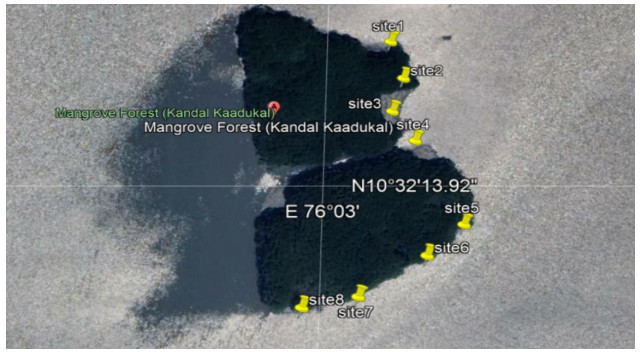









 DownLoad:
DownLoad:










